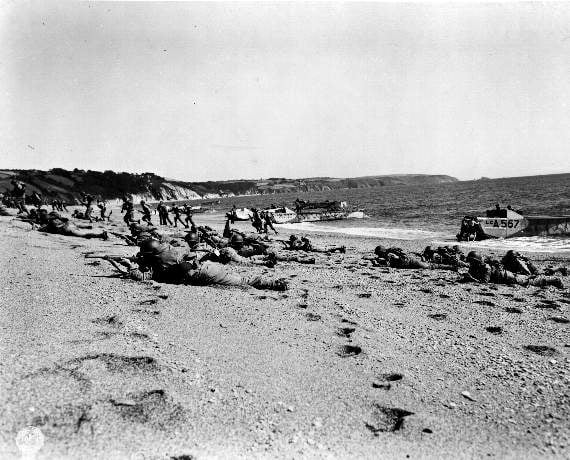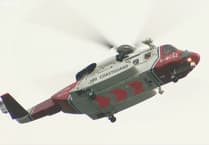A newly published book provides a detailed reappraisal of Exercise Tiger, claiming to set the tragedy in “its proper context”.
Exercise Tiger was the American dress rehearsal for D-Day that took place in Start Bay during the Second World War. And London author, Nigel Lewis has written a comprehensive account of the events surrounding the exercise, unearthing several surprises about the disastrous incident.
“In late April 1944, as Exercise Tiger went through manoeuvres in Lyme Bay, the Allies had already taken steps behind the scenes to weaken its defences, and pick it out for enemy attention,” Lewis claims. “As a result, German torpedo-boats attacked the final convoy of the exercise, and 639 American lives were lost.”
That is not the story that’s been told in the South Hams since 1944, and not the story that Lewis once told. Thirty years ago, in his book ‘Channel Firing’, he saw the attack on the Tiger convoy as a more or less random happenstance of war. By contrast, his new book about Exercise Tiger is called ‘The Cover Plan Conspiracy’.
“I stand by my reconstruction of the German attack,” Lewis continues. “But my earlier book has nothing useful to say about the Allied background to Tiger. There I was conned, as everyone else has been since the war. My new book puts that right by setting Tiger in its proper context - the air-sea war on the English Channel, and the Allied deception plan or so-called ‘cover plan’ for the Normandy landings.”
His reappraisal of Tiger is also, he says, a new history of the ‘cover plan’ - the master-narrative of the Allied deception, known as ‘Fortitude South’. The plan was to deceive the Germans into believing the Allies were going to land across the Straits of Dover at the eastern end of the Channel, in the area of north-eastern France known as the Pas de Calais.
“The Pas de Calais,” Lewis points out, “was too far away to be a plausible target for US forces in the Westcountry and South Wales. But in that case, what was the cover story for the US forces in the west supposed to be?”
Lewis says he is the first person to ask this question.
“Plymouth and the Westcountry consistently presented the deceivers with a problem, and part of the answer to it was the deceptive deployment of Exercise Tiger,” Lewis said.
It was another, unacknowledged dimension to the 'cover plan', which Lewis calls ‘Fortitude West’. His research reveals that Exercise Tiger was much more than a D-Day training exercise.
“The Tiger codename never comes up in connection with the ‘cover plan,’” he said. “But documents in the National Archives show that ‘the Force “U” exercise’, as it was called, was closely linked with the plan.
“On April 24, the storm of wireless-telegraphy that launched the plan coincided precisely with the start of Tiger. Stitched into the detail of the W/T deception, it also coincided with the launch of the fictional Allied army group, FUSAG, at the eastern end of the channel.
“There were five Allied naval rehearsals for D-Day. Tiger was the first one, the only one to be held on its own, and the only one in the western Channel. It lasted longer than any of the others, and its naval defences were by far the weakest of the five,” Lewis said. “As if all this wasn’t enough, the day it put to sea - April 26 - was the day that Hitler had identified as the day the Allies would invade across the channel.”
One of Lewis’s most shocking discoveries is that the RAF secretly enabled a German air reconnaissance of Tiger on the morning of April 26.
“By cancelling air patrols of Plymouth Command scheduled for that morning, they left a window of opportunity open to the enemy. Then when a German air recce flew into Lyme Bay, they disguised its identity, misreporting it as a sea reconnaissance ‘off Dartmouth’,” he said.
“The RAF radar-plot of this recce is a fake,” said Lewis. “Its real flight-path was overland towards Brixham. An antiaircraft-gun near the village of Coleton fired on it as it passed overhead. Over Torbay, it photographed the combat-loaded ships of Exercise Tiger, including a landing-ship later sunk in the torpedo-boat attack.
“The reconnaissance tipped off the enemy that Allied amphibious troop-movements were under way. The British knew that the Germans knew this. The Americans did not know. The story was that the German torpedo-boats were on a routine patrol when they happened to run into Tiger’s final convoy. But that no longer stands up. They had been tipped off by the air reconnaissance, and knew their target in advance.”
This leads on to perhaps Lewis’ most shocking revelation: “If Tiger was not conceived as a sacrifice operation, it certainly became one.”
But sacrifice to what end? There are a number of possibilities, which Lewis describes in his book. But one was “simply to make sure that the ‘cover plan’ was comprehensive and watertight".
“A deception narrative is like a chain, only as strong as its weakest link, which happened to be in the Westcountry. People forget that Fortitude, for all its fantasy, was one of the crucial Allied operations of World War Two. If it had failed, so probably would the Normandy invasion itself have failed,” Lewis said.
‘The Cover Plan Conspiracy, the British and Exercise Tiger, 1944’ is published in four parts, and is available as an e-book online at www.amazon.co.uk.





Comments
This article has no comments yet. Be the first to leave a comment.